Occupational environment monitoring at the factory producing batteries
99,000 ₫
Note: The above price is calculated for one sample. Prices may fluctuate depending on the area of the environment to be monitored and market conditions. For more accurate pricing support, please refer to the price list or contact our consulting staff directly.
Workplace environment monitoring for a battery manufacturing factory is a session of collecting, analyzing, and evaluating factors at the workplace that may be harmful to workers health.
Table of Contents
Toggle1. Overview of Battery Production Factories
a. What is a battery production factory?
A production factory for batteries is a specialized facility designed to manufacture various types of electrochemical batteries. These batteries convert electrical energy into chemical energy and store it for use in electronic devices, portable tools, electric vehicles, energy storage systems, and many other applications.
The battery production process may vary depending on the type of battery and the specific production technology used in the factory.

b. Production stages in a battery production factory
Production stages in a battery production factory may include:
- Raw material preparation: Essential materials for battery production, including metals such as lithium, nickel, cobalt, manganese, copper, and other electrolytes, are prepared and quality-checked.
- Electrode formation: Key components of the battery, such as the anode and cathode, are formed from suitable materials and mixtures. This process includes blending, mixing, pressing, or molding to create the structure and shape of the electrodes.
- Assembly and connection: Battery components, including anodes, cathodes, casings, impact-resistant pads, and other electrode materials, are assembled and connected to form a complete battery structure.
- Electrolyte filling: Battery components are filled with electrolytes, a conductive liquid or gel, to create electrochemical interactions between the anode and cathode.
- Packaging and protection: Assembled and finished batteries are packaged in protective casings for safety and storage. Packaging may include adding battery covers, protective wraps, and other accessories.
- Testing and inspection: Batteries are tested and inspected to ensure quality and performance meet standards. Key technical parameters such as capacity, voltage, lifespan, and safety are verified using specialized equipment.
- Sealing and final packaging: After testing and inspection, batteries are sealed or finally packaged to ensure safety during transport and use.

c. Machinery used in battery production factories
Battery production factories use a variety of machinery and equipment to carry out the production stages. Some common machines include:
- Punching machine: Used to cut, punch, and process metal components such as current collectors, caps, and other battery parts.
- Pellet press: Used to compress raw materials into pellets to form anodes and cathodes.
- Mixing and blending machines: Used to prepare and mix materials such as metals, compounds, and electrolytes during battery production.
- Pressing, molding, or extrusion machines: Used to create the shape and structure of battery components such as electrodes and other parts.
- Polarization and electrolysis machines: Used for the polarization and electrolysis process of battery components to generate electrochemical performance.
- Surface treatment machines: Used for cleaning, washing, or coating protective layers on battery component surfaces.
- Measuring and testing machines: Used to verify technical parameters such as voltage, capacity, lifespan, and safety.
- Welding machines: Used to weld metal parts or make connections during battery assembly.
- Printing and marking machines: Used to print labels, barcodes, or mark important information on battery components or packaging.
- Packaging machines: Used to package finished batteries in protective cases and final packaging.

d. Occupational diseases for workers in battery production factories
Workers in battery production factories may be exposed to occupational hazards that can cause various occupational diseases. Common diseases include:
- Metal toxicity: Workers may be exposed to toxic metals such as lead, mercury, and cadmium. Prolonged exposure without protection can cause lead poisoning, mercury poisoning, and cadmium poisoning.
- Respiratory diseases: Battery production generates dust, fumes, and irritants that may lead to pneumonia, sinusitis, cough, and other respiratory problems.
- Skin diseases: Contact with chemicals and cleaning agents can cause irritation, dermatitis, dryness, and allergic reactions.
- Ear, nose, and throat diseases: Some chemicals can irritate or adversely affect the ears, nose, and throat, causing itching, runny nose, cough, breathing difficulties, and sore throat.
- Noise-related diseases: Machinery and equipment can produce high noise levels, leading to hearing loss and related ear problems with prolonged exposure.
- Work-related stress: Continuous work, workload pressure, and extended hours may cause mental and physical stress.

e. Common types of batteries on the market
There are various common types of batteries available, each serving different applications:
- Lithium-ion (Li-ion) batteries: Widely used in mobile phones, laptops, digital cameras, and other portable electronics. They have high energy density, relatively long lifespan, and good capacity retention.
- Lithium Polymer (Li-Po) batteries: Similar to Li-ion, used in many mobile devices. Li-Po batteries are thin, lightweight, flexible, and can be designed in special shapes and sizes.
- AA and AAA batteries: Standard batteries used in flashlights, remote controls, clocks, and other small electronics. Typically alkaline or zinc-carbon, providing stable power for small devices.
- Automotive batteries (Lead-acid): Used in cars, providing large, reliable energy to start engines.
- Solar batteries: Use solar cells to convert sunlight into electricity, used in solar power systems, solar lights, and mobile devices with integrated solar panels.
- Lithium-ion polymer (Li-Poly): An improved version of Li-ion batteries, used in mobile phones, laptops, and music players.
- Alkaline batteries: Use alkaline metals to generate electricity, commonly used in household devices such as clocks, flashlights, remote controls, and toys.
2. Overview of Occupational Environment Monitoring Services
a. What is occupational environment monitoring in battery production factories?
Occupational environment monitoring (or workplace environment measurement) in battery production factories involves collecting, evaluating, and analyzing indicators of workplace environmental factors. The purpose is to implement timely measures to reduce environmental hazards to worker health and prevent occupational diseases. Workplace monitoring is mandatory for all battery production factories.
Monitoring plays a crucial role in protecting and enhancing worker health, as workers are the main resource generating profit for the enterprise. Prolonged exposure to excessive occupational hazards can adversely affect health and cause occupational diseases.
REGISTER FOR OCCUPATIONAL ENVIRONMENT MONITORING SERVICE
b. An Toan Nam Viet’s occupational environment monitoring program
An Toan Nam Viet’s occupational environment monitoring program is developed by monitoring engineers specializing in occupational safety and environmental protection. To ensure worker safety and health, the program uses modern measurement methods to monitor air, water, microclimate, physical factors, dust, and other workplace conditions. This program is essential to maintain a safe working environment and protect worker health.
Additionally, the program plays a vital role in researching and developing new solutions to improve workplace environmental quality. With the dedication and professionalism of An Toan Nam Viet’s monitoring experts, this exclusive program is a breakthrough in occupational safety and environmental management in Vietnam.

c. Standardization in workplace measurement procedures
Standardization in An Toan Nam Viet’s workplace measurement procedures ensures accurate and reliable results. The program follows standards recognized by the Ho Chi Minh City Department of Health. This guarantees that collected data can be reliably used to assess workplace conditions and make informed decisions to improve occupational health.
Standardized procedures also ensure measurements are conducted by highly qualified monitoring specialists with years of experience, allowing managers and experts to trust An Toan Nam Viet’s results and make accurate decisions to protect worker health and the environment.
By applying standardized procedures, An Toan Nam Viet demonstrates its commitment to providing a safe working environment and protecting worker health while contributing to improving occupational safety and environmental management in Vietnam.
d. Reporting monitoring results for battery production factories
Monitoring results are prepared according to Form No. 04, Appendix III, issued with Decree 44/2016/ND-CP and compiled in two copies: one sent to the contracting enterprise and one retained by the monitoring organization.
The retention period is indefinite, in accordance with legal requirements.

e. Frequency of occupational environment monitoring as required by law
According to Clause 2 of Article 18 of the Law on Occupational Safety and Hygiene 84/2015/QH13, employers must conduct occupational environment monitoring at least once per year.
f. Deadline for submitting monitoring reports according to law
The deadline is before December 31 each year. Enterprises must submit monitoring results to the local Department of Health where their headquarters and workforce are located.
When there are changes in technology, production processes, or factory upgrades introducing new hazardous factors, enterprises must update occupational hygiene records related to harmful factors requiring monitoring.
g. Penalties for violations of occupational environment monitoring regulations for employers
According to Article 27 of Decree No. 12/2022/ND-CP dated January 17, 2022:
- Clause 2: Fines from 2,000,000 – 5,000,000 VND for employers who fail to publicly inform workers at the monitoring site and workplace immediately after receiving monitoring results.
- Clause 3: Fines from 20,000,000 – 40,000,000 VND for employers who fail to conduct occupational environment monitoring as required by law.
- Clause 4: Fines from 40,000,000 – 60,000,000 VND for employers who collude with monitoring organizations to commit fraud in monitoring activities but not to the extent of criminal liability.
3. Harmful environmental factors for workers in battery manufacturing factories
During battery production, workers may be exposed to several harmful environmental factors. Below are some potential environmental hazards that can affect workers in battery manufacturing factories:
- Toxic chemicals: Battery production may involve the use of toxic chemicals such as sulfuric acid, electrolytes, and heavy metal compounds. Exposure to these substances can irritate the skin, eyes, and respiratory system, and in more severe cases, cause serious health problems.
- Chemical dust and fumes: Battery production processes can generate dust and chemical fumes that may be harmful when inhaled or in contact with skin. These substances can obstruct the respiratory tract, cause irritation, and lead to inflammation.
- Noise: Some processes in battery manufacturing, such as pressing, cutting, and assembly, can generate high levels of noise. Continuous and excessive noise can cause stress, affect hearing, and lead to other health problems.
- Temperature and humidity: Certain battery production processes may create working conditions with high temperature and humidity. These conditions can cause discomfort, fatigue, and negatively impact worker health and performance.
- Impact from materials and equipment: During battery production, workers may handle materials such as metals, glass, plastics, and high-tech equipment. Handling and exposure to these materials and equipment can pose risks of injury, cuts, impacts, and other accidents.
REGISTER FOR OCCUPATIONAL ENVIRONMENT MONITORING SERVICE
4. Measures to improve working conditions in battery manufacturing factories
To improve working conditions in battery manufacturing factories and protect worker health, the following measures can be implemented:
- Chemical management: Ensure the safe use and storage of hazardous chemicals according to regulations and safety standards. Train employees on proper and safe chemical handling procedures.
- Ventilation and exhaust systems: Provide effective ventilation in the factory to remove toxic gases, chemical fumes, and dust generated during production. Ensure exhaust systems function properly to minimize negative impacts on the environment and employee health.
- Material and equipment safety: Provide personal protective equipment such as safety goggles, masks, gloves, chemical-resistant clothing, and safety shoes to reduce direct exposure to hazardous and dangerous substances. Perform regular inspection and maintenance of equipment and machinery to ensure safety and operational efficiency.
- Employee training and education: Provide training on occupational safety, safe work procedures, and occupational disease prevention. Enhance awareness of potential hazards and preventive measures in battery production processes.
- Inspection and monitoring: Conduct regular inspections to assess safety levels and compliance with workplace regulations. Monitor employee health to detect early signs of work-related health issues.
- Create a comfortable working environment: Maintain stable and comfortable temperature and humidity conditions to reduce stress and fatigue. Provide rest areas and amenities such as cafeterias, restrooms, and small recreational spaces to improve workers’ quality of life.
- Promote safety awareness: Foster a work environment that values safety and health awareness. Encourage employees to participate in training and activities that enhance safety consciousness and compliance with relevant regulations.
- Periodically conduct occupational environment monitoring in factories to collect and analyze harmful factors affecting workers, and adjust measures to reduce risks and prevent occupational diseases.
5. Benefits of periodic monitoring in battery manufacturing factories
An Toan Nam Viet provides businesses with valuable benefits when using occupational environment monitoring services in accordance with Decree 44/2016/ND-CP on managing and controlling harmful factors in the workplace affecting employees.
- Businesses can proactively control harmful factors in workshops or factories.
- Receive consultation and recommendations on measures to reduce harmful factors and improve workplace quality.
- Indirectly protect human resources, a key factor in business development.
- Reduce the harmful effects of occupational diseases on employee health, minimizing future treatment costs.
- Enhance worker health, ensuring product quality and maintaining production output.
- Ensure compliance with labor safety regulations, avoiding legal risks.
- Enhance credibility and professionalism in all aspects, elevating the company’s brand.
Nam Viet’s environmental monitoring service is a solution to reduce occupational disease risks, contributing to a clean and high-quality working environment.

6. National occupational environment monitoring center
Occupational environment monitoring center of Nam Viet is a professional unit specializing in monitoring and measuring workplace environmental quality across all provinces in Vietnam. With a team of experienced monitoring specialists, the center uses modern measurement equipment to ensure accuracy and reliability.
In addition to providing monitoring services, the center supports clients in planning, managing, and tracking occupational environmental issues. With the motto “customer-centered,” the center prioritizes client satisfaction, meets all client needs, and commits to providing the best solutions for businesses.
REGISTER FOR OCCUPATIONAL ENVIRONMENT MONITORING SERVICE
With investments in technology, equipment, and human resources, Nam Viet’s monitoring center has become one of the most reputable units in occupational environment monitoring in Ho Chi Minh City, with the following objectives:
- We always value our brand reputation and the quality of our service products.
- We provide clients with the best and most suitable solutions possible.
- With a team of experienced Masters and Engineers, committed to environmental protection and benefiting businesses.
- By choosing Nam Viet Environmental Monitoring, companies receive professional service from experts and the best cost advantages.
The occupational environment monitoring process at Nam Viet includes the following basic steps:
- Before monitoring, the company ensures all equipment is calibrated according to legal regulations.
- Follow occupational environment monitoring procedures accurately as committed to the Department of Health.
- Report monitoring results honestly to employers.
- If monitoring results indicate unsafe conditions, Nam Viet provides corrective solutions, and the workplace implements the following:
- Implement measures to improve working conditions, minimize harmful factor impacts, and prevent occupational diseases.
- Conduct health examinations to detect occupational and related diseases early for workers in unsafe environments.
- Provide in-kind compensation to workers according to labor law.

7. Occupational environment monitoring quotation
To help businesses conduct professional and effective occupational environment monitoring, Nam Viet provides clients with a quotation for occupational environment monitoring services that is high-quality and reasonably priced.
- Our quotation provides detailed pricing information for the monitoring services we offer, including costs related to travel, measurement, analysis, and reporting. Clients can trust the accuracy and reliability of the monitoring reports we provide.
- We commit to offering competitive and reasonable prices in the market and are always ready to provide quick and professional advice for any inquiries regarding monitoring services.
- With Nam Viet’s monitoring quotation, clients can easily select service packages suitable to their needs. We are committed to delivering the highest satisfaction with professional service quality.
No comments yet

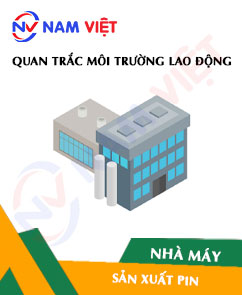
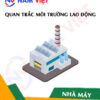
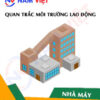

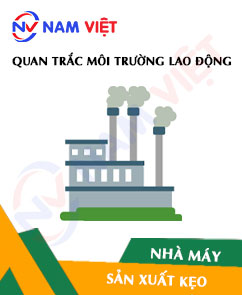


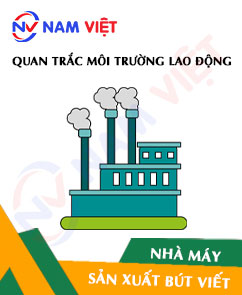



Review Occupational environment monitoring at the factory producing batteries
There are no reviews yet.